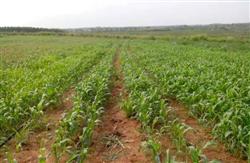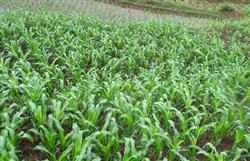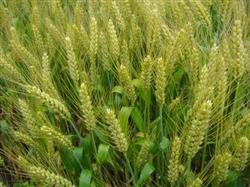How to plant spring sorghum?

How does spring sorghum grow well? Please give an introduction Sorghum planting can be divided into spring and autumn planting two kinds. Spring sowing period is about from the end of March to the middle of April of the lunar calendar, and the time should not be too early, because the early sowing temperature is low, the growth is slow, and it is easy to die when encountering cold current. Autumn sowing is selected between the late May and the late June of the lunar calendar, and the time should not be too late, so as to avoid delaying the maturity due to low temperature in the middle and late stages of growth. The cultivation process is roughly as follows: Soil preparation: first spread compost on the cultivated land, then plow 12 - 15 cm (4 - 5 inches) deep, thoroughly break the soil, remove weeds, and rake the soil surface, digging 4 - 6 cm deep planting trenches according to the row spacing of 50 cm. Sowing quantity: About 15~20 kg seeds per hectare. Seeds can be purchased from local township farmers 'associations. Seeding method: Seeding method is divided into two kinds: dibbling and drilling. Generally, drilling is the main method. Seeds are evenly sown in planting ditches and then covered with soil about 3 cm thick. Fertilization method: (1) Spring and autumn crops: compost is spread in the field before soil preparation, and then turned into soil. The full amount of phosphorus fertilizer and half amount of nitrogen and potassium fertilizer are used as base fertilizer before sowing, and the remaining half amount of nitrogen and potassium fertilizer is applied 30 days after sowing. (2)Perennial root cultivation: half of the fertilizer is applied 10 days after harvest of the main crop, and the remaining half is applied 30 days after harvest of the main crop. Fertilizers should be applied 10 - 15 cm away from the plant to avoid damage to the plant. Field management: (1) Thinning and replanting: 20~25 days after sorghum sowing, when the seedling height is 15 cm, carry out the first thinning, until the seedling height is 25~30 cm, carry out the second thinning, and finally keep the plant spacing about 10 cm. If there is a lack of plants, dig out the healthy seedlings to be removed from the thinning seedlings for replanting. (2)Cultivation and weeding: During the growth period of sorghum, according to the occurrence of weeds, implement cultivation and weeding 2~3 times, especially in the early stage of growth, pay special attention to weed removal, so as not to affect development. If herbicides are used, they should be sprayed after sowing and before germination. (3)Soil cultivation: after the first intertillage and weeding, topdressing is applied next to the plant and soil is cultivated on the stem of the plant to prevent lodging and promote development. (4)Irrigation and drainage: sorghum drought resistance, but in the young ear formation period (about 35 days after sowing),(about 60 days after sowing), milk maturity period (about 75 days after sowing) in case of drought, affecting the yield is very large, should be appropriate irrigation. During rainy season, stagnant water should be drained at any time to avoid pests and diseases and prolong maturity. Perennial root (regeneration) cultivation: (1) stem cutting: spring harvest, immediately cut the stem 1 - 2 cm from the ground, the earlier the better. (2)Fertilization: Fertilization amount and fertilizer type Fertilization period as described above. (3)Sparse buds: After cutting stems, the number of buds per plant can reach 2~5, but each plant should keep two healthy buds as the principle, and the rest of the buds should be removed as soon as possible to avoid absorbing nutrients. (4)Other management: such as intertill weeding, harvest modulation and other operations are the same as the general cultivation method of sorghum. Click for more sorghum cultivation technology Click for more grain cultivation technology
- Prev

How to manage sorghum seedlings?
How to manage sorghum seedlings? Please give guidance to sorghum seedling management can refer to the following methods for management: 1. Chemical weeding: chemical weeding should be carried out 3 days after sowing. Every hectare should be sprayed with 3.5kg atrazine and 400ml 500kg water. In case of dry weather, spray water once within two days and spray wet.
- Next

When is it good to control wheat scab?
When is it good to control wheat scab? Please guide the pathogen of scab is generally on the high side, mostly exceeding the pandemic index. Once the epidemic occurs, it will not only seriously affect the yield of wheat, but also lead to the loss of wheat utilization value. It is observed that under the condition of drought, most wheat varieties are vulnerable to scab. Special.
Related
- The first cup of black tea in spring, the flavor and history of tea gardens in Kenya, Africa
- The computer can not only choose potatoes, but also grow tea rice. AI will grow winter oolong tea champion.
- It is not only the inflated tea bitten by insects, but also engraved with the four seasons tea in Beipu.
- The Oriental Beauty Tea Festival in Zhuxian County takes the stage at the weekend to experience the plus-size feast of oil tea.
- & quot; Oriental Beauty Tea & Exploration of Emei in Hsinchu, the hometown of quot;
- The new variety of strawberry "Tainong 1" dessert is the first choice with mellow aroma. Crimson gorgeous
- History of Tea in Taiwan: from Wild Inner Mountain to Export Tea Garden
- Two types of Taiwan Oriental Beauty Black Tea won the British three-Star Award for Childhood Tea Xiang Zhang Jiaqi changed from pilot to champion tea maker.
- Banana species and varieties: the planting history of Taiwan Xianren banana and dwarf banana is long, is banana disease resistant?
- Coffee planting Technology: Qianjie Coffee from Seedling to harvesting

